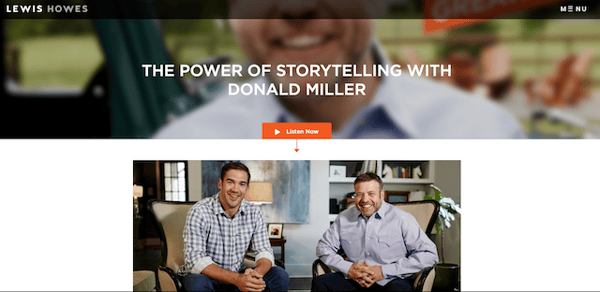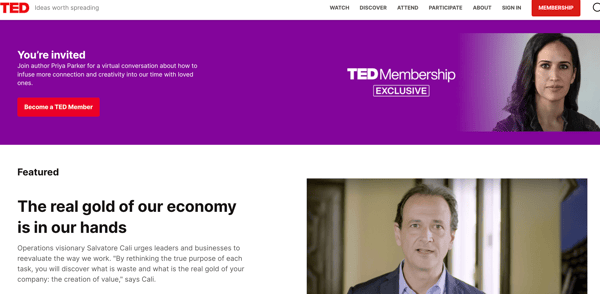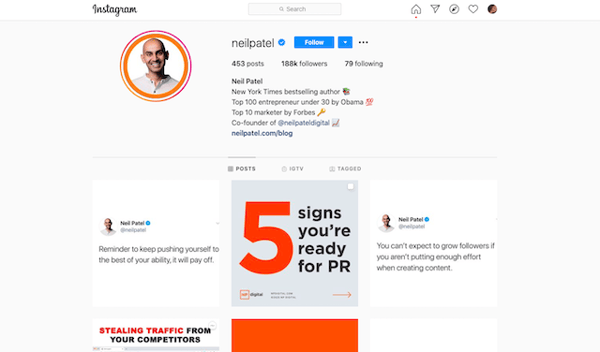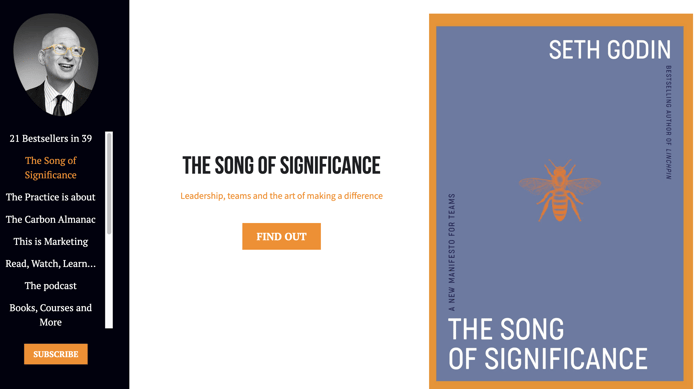How to Create Thought Leadership Content
- 1. Decide What Your Angle Is.
- 2. Consider Your Release Schedule.
- 3. Assign Roles to Your Team.
- 4. Do Your Research.
- 5. Determine the Best Way to Bring the Data to Life.
- 6. Develop and Launch Your Thought Leadership Piece.
- 7. Update Your Existing Thought Leadership Content.
- 8. Find Out What Your Audience Wants to Know.
Your organization's content marketing strategy relies on your team's ability to develop awesome thought leadership content.
Unfortunately, becoming a “thought leader” is so sought after by enterprises great and small that the original meaning has become diluted over time.
What Is Thought Leadership?
Thought leadership helps build your audience’s trust in your expertise, but this is an effect rather than a cause. One isn't a thought leader simply because they put out valuable, thought-provoking content, they become a thought leader because others recognize them as thought leaders—though creating that thought-provoking content helps!
“Doing thought leadership” isn’t simply about providing high-quality products or services. It's about bringing your industry to a higher level of thinking about the strategic problems it faces.
Individuals and businesses alike can aspire to thought leadership, but it all starts with a clear understanding of the term itself.
A true thought leader is influential not only because of how they do things but also in their ability to explain why a certain approach is better.
Thought Leadership Marketing Best Practices
Leaving a lasting and meaningful impact on your audience is no easy feat. Becoming a top thought leader in your industry requires you to apply a mix of these five best practices.
Engage With Your Audience.
This one may seem like a no-brainer, but engaging with your audience may prove difficult for companies that are short on time.
Engaging with your audience means that you must find clever ways to get them involved in the conversations that you raise with your content. Ask for their opinions, respond to their questions, and develop content based on some of those conversations.
The easiest way to engage with your audience is through social media. For instance, you may try LinkedIn because it allows users to create virtual group discussions.
Be Consistent on Social Media.
Social media is a great place for thought leaders to reside. In fact, many thought leaders produce content specifically for social media to increase their following.
Sharing corporate blog posts and individual posts from the thought leaders in your company can help to build a community. You can also use social media to showcase your teams' expertise, including when they present at industry events and when they are mentioned in the press.
The main thing you have to do with social media is remain consistent with your posting schedule and the on-brand content you post.
Posting once every three months won't help you to become a trusted thought leader in your industry.
Get Your Thought Leaders in Front of a Different Audience.
Thought leadership is not limited to the content that you create and promote. To spread your message, you need the thought leaders in your company to have more exposure. This creates more buzz and expands your audience.
A good way to get them exposed is to:
- Submit proposals for speaking engagements.
- Get them to guest star on partner podcasts and webinars.
- Make connections in the media.
- Search for guest blogging opportunities.
Make Sure Your Team Is Aligned.
Any team members who are involved in your thought leadership strategy should understand the returns that thought leadership brings your company. Creating and implementing a strategy that accurately outlines the execution of your thought leadership strategy helps to keep your whole team in the loop.
Another way to keep your team aligned is to share data reports with them to show which content resonates the most with your audience.
For instance, if you have a series of short videos posted on YouTube that are resulting in high engagement, then your team should continue to work on new videos. Why? Because this engagement helps keep the thought leaders at the forefront of your audience's mind. Having them switch to other types of content could cost you momentum with your core audience.
Start Your Thought Leadership with Amazing Content.
Amazing content is the key to excellent thought leadership. Make sure your content is accurate, informative, and entertaining before it is published to make sure you can easily attract your target audience.
If you already have a content marketing strategy, then adding in your thought leadership ideas may be easier than you think.
Why Is Thought Leadership Important?
There are some pretty amazing benefits to participating in a thought leadership strategy. There are leaders everywhere and content is bigger than just marketing. Thought leadership exposes your business to your market in a credible way.
Your business benefits tremendously if you can develop great content.
You Become Part of the Conversation.
Early in the buyer’s journey, consumers are looking into their needs and the best avenues to meet them. If you can meet them upfront with some valuable content that helps them, then you’re presenting your company as a viable option to invest in.
You also gain more authority by consistently contributing high-value information to industry conversations.
Participating in online forums and debates is a way of getting your foot in the door and raising a hand to say, “Hey, I know a thing or two about this as well.” Additionally, being part of these discussions can help your thought leaders keep their
Your Audience Gets to Know Your Business.
If you’re the first to greet them, then you’ll be top of mind through their entire journey.
Putting quality, personable content out there lets your audience get to know your voice and personality. You’re a representative of your company, so they’ll associate you with your business.
If you have a more light-hearted, familiar tone of voice, they’ll view your company as pretty welcoming and laid back. If you’re more intellectual and straightforward, then they’ll assume your company is more professional and savvy.
Your thought leadership content can contribute toward your business’ reputation, so guide it in a way that’s appropriate for your industry.
Your Brand Gains Exposure.
The more high-value the information that you put out is, the more people will begin to associate you with a particular pain point or market.
If your thought leadership content is really good, it can even go viral and reach a larger audience as those who read it discuss it and share it with others.
Brand awareness and reach are important in the grand scheme of lead generation. You won’t get any customers if no one knows about you. Thought leadership is a great way to introduce yourself to the world and get your brand out there.
You Become More Engaged In Your Industry.
From an industry standpoint, it never hurts to have your peers look at you as a thought leader or resource. That shouldn’t be restricted to leads only.
When other companies see that you’re knowledgeable and capable, you earn their respect and attention. That can lead to partnerships, referrals, and greater exposure.
What Makes Great Thought Leadership Content?
Thought leadership content should not only go a step beyond your regular content. It should also be treated as something of an “event” in your enterprise.
Larger content teams with robust, mature processes may even have writers, researchers, and designers solely for this content. The content should always be at least one of four things:
Valuable
There’s definitely a difference between normal blogging and publishing thought leadership content. The latter is meant to provide more insight and information to your audience that they weren’t aware of before.
You can’t post common knowledge and call it thought leadership. It needs to be valuable and share-worthy. Coming up with content that will truly interest your readers can be tricky, but proper research and ideation go a long way.
Educational
In B2B industries, sharing knowledge is important in establishing yourself as an expert and a leader in your industry. Every piece should have some sort of actionable takeaway or guide that will help assist the reader in their future efforts.
If the reader isn't learning something from the content, they may end up thinking of it as fluff rather than as thought leadership.
Accurate
You’re setting yourself up to fail if you’re marketing your content as valuable and educational, but your content is generic or worse, inaccurate. Words are easy to spin, and you can write a 5,000-word article talking about absolutely nothing.
Don’t try to deceive your audience just for the sake of being seen as a thought leader. They’ll catch on quickly and you’ll be known as a fake instead. Take the time to do proper research and verify your own resources for accuracy.
Targeted
In order for your content to feel relevant and contextual, you’ll need to have an idea of who your target audience is and what they want. Without it, the messaging in your thought leadership content could appear a bit scattered and misguided.
You’ll want to target other industry professionals along with your prospects. Providing value to executives, developers, and other decision-makers makes you more appealing to work with when there are opportunities for partnerships.
The advantage here is that thought leadership content, which takes more time and resources, could run on a parallel track alongside your regular content – which usually comes out weekly.
Even if you have a smaller, more focused team, however, you can still succeed in thought leadership. To do it, though, you’ll need to adjust your planning and production process.
How to Create Thought Leadership Content in 8 Steps
Developing content that's above average without feeling too "high and mighty" or talking down to readers can be tough. Where do you start? How do you balance the need to explain things with the estimated level of understanding your audience already has?
More importantly: How do you prove you know your stuff?
Follow these six steps to set your team up to create awesome thought leadership content.
1. Decide What Your Angle Is.
The average piece of content is focused on the needs, questions, or problems of your buyer persona. The content connects with prospects or current customers by helping them with a very specific issue they’re researching or confronting in the moment.
Thought leadership content is different: It speaks to an entire way of doing things.
Your audience for this content may be your industry peers, decision-makers at major enterprises, the press, or even the academic community.
However, it will not usually deal with one practical, immediate problem. Instead, it is part of a broader industry conversation.
That means you need to start with a strong position on a meaningful, relevant topic.
Your “angle” can be simple. You can take a stand against a common assumption that plagues your industry. You can string together a number of positions and make predictions about the future. Or you can explicate upon an area of strength by providing new perspectives on it.
Host ideation sessions to brainstorm with your team. These sessions bring everyone together and help you hone in on an important topic that aligns with parts of your content marketing strategy, like the keywords you targeted in your SEO strategy.
Whatever you do, however, your thought leadership content should contribute to the ongoing dialogue in your field – either adding nuance or taking it in a new direction entirely.
Usually, this will require some “pre-research” to uncover an area where your voice can make the most meaningful addition.
Industry periodicals, websites, and – perhaps most importantly – the expert opinions of your company’s top decision makers will all factor in here.
2. Consider Your Release Schedule.
For thought leadership content to make the biggest impact, it shouldn’t simply be released on your blog any old time. Ideally, you’ll be able to leverage outside events to focus significant industry attention on your informative new release.
It might seem strange to be thinking about the calendar before you even embark on developing your content, but it can actually help in a variety of ways.
When you have a specific target event in mind, you’ll be able to develop a complete schedule for researching, building, designing, and editing your content. Milestones can be assigned hard dates, essential in an iterative process where each step depends on the previous ones.
You’ll be better able to resist the temptation to get lost in any particular step in the process.
Plus, you’ll be able to lay the groundwork for fresh thought leadership content to make the biggest splash. That may mean booking time to speak at an industry conference or even planning a gathering of your own. It may mean reaching out to media outlets.
It should certainly include a concerted launch effort on social media and your subscriber list.
All these things take time, so defining your parameters first will make a big difference.
3. Assign Roles to Your Team.
Depending on the size of your team, your thought leadership creation process could involve a lot of moving parts. You need at least a few key roles filled during the content creation process.
Some roles you want to assign to people might include:
- Writers: Obviously, you want a team of awesome writers to share information in a compelling way.
- Editors: You want fresh eyes on the content your writers are creating. If writers are also taking on editing duty, make sure they have some time to step away from the content before rereading it.
- Subject Matter Experts: Who best understands the topic to provide meaningful insights and ensure that anything your team puts out is correct? Having one or more subject matter experts (SMEs) in the topics you want to demonstrate thought leadership in is crucial for success. These SMEs could also fill in as writers or editors (or both).
- Designers: Depending on the level of complexity of your thought leadership content, a designer can help design the new report, whitepaper, ebook, or whatever other content format you choose.
- Community Manager: This person oversees the promotional side of the content, helping distribute it through PR, SEO, and more while also overseeing social media campaigns and engaging with your brand’s community.
- Analysts: You need someone to measure the impact your thought leadership content has on your industry so you can fully understand how well it performed and adjust your content creation strategy based on analytics reports.
4. Do Your Research.
Most thought leadership content is built on original research that comes directly from the issuing organization.
This research, in and of itself, is part of what makes the resulting presentation unique. It creates new bedrock facts that others are obliged to take into account and respond to.
Of course, there are many ways to do research.
Quantitative research is what most people think of first in the age of big data. It is based on objective measurements using mathematical or statistical approaches. If you have vast amounts of data at your fingertips, this is the way to go.
It is not the only way, of course. There’s also qualitative research, which can explore the reasoning, opinions, and motivations of a target group.
For example, polls and focus groups conducted with potential customers are all qualitative artifacts, but they’re no less valuable when they’re used in compelling ways.
Original research is the “secret sauce” for thought leadership content, but there are drawbacks:
- Conducting research is a daunting, time-consuming task not everyone can do in-house.
- Data and underlying assumptions will age, so the resulting content isn’t “evergreen.”
These are two reasons why, in contrast to “average” web content, thought leadership content tends to be cyclical.
It takes a while to define, process, introduce, and exploit a big idea. Then, as the novelty wears off, it’s just as vital to move forward to the next frontier quickly.
If your enterprise simply can’t do the research, it doesn’t mean you’re locked out of the thought leadership game.
Many established enterprises turn to third-party researchers to investigate emerging issues and trends, and then build out the data into a cohesive end product.
For research into markets, attitudes, trends, and other things that can change frequently, conducting new studies is vital for keeping your insights fresh and relevant. Also, it gives others new information to cite and link to—helping to build your backlinking strategy!
5. Determine the Best Way to Bring the Data to Life.
Raw data can sometimes have its own beauty, but it’s rarely conventionally “interesting.”
The huge popularity of infographics goes to show that people are most excited by data when they can look at it from an unexpected perspective. With the right principles in mind, data can be intuitive, intriguing, and instructive. In many cases, it can even be fun.
Bringing the story out of the data comes down to two interrelated decision points:
Format
Thought leadership can utilize any format regular content uses. It can come in the form of a series of blog posts, videos, a virtual event, an ebook, and much more.
The format chosen should help simplify and streamline the overall narrative that you want to explore with the data.
Branding
It should also inform and support your voice – your method of imbuing the content with your brand’s unique imprint.
For example, many companies have released thought leadership pieces anchored by an interview with their CEO or other leading decision-makers.
Others have used “behind the scenes” footage of teams in action, often with brief leadership commentary.
In both these cases, top stakeholders define the company voice by actually, well, speaking.
That said, thought leadership does not have to be structured as a conventional discussion or dialogue. Although some of the best thought leadership content is multimedia, the majority takes a somewhat conservative approach as a long-form report or whitepaper.
6. Develop and Launch Your Thought Leadership Piece.
Depending on the size and scope of the expected piece, writing (or filming, designing, or all three) could take anywhere from weeks to months.
No matter your choice, it’s crucial to give your team enough time to not only produce the content, but test and fact-check it.
When thought leadership is positioned and launched correctly, it gets a lot more attention than the average post and putting your best foot forward is essential.
Likewise, dedicating social media and digital marketing assets is key.
Since thought leadership is usually time sensitive, you should think about it the same way you would a new product or service launch – building up anticipation well in advance, leading to a “launch event.”
The best thought leadership content gets responses – often very quickly.
Prepare accordingly by ensuring a branded hashtag is associated with the piece and that the social media team is watching it closely.
A member of the content team should be designated to either make replies or, if the “respondent of record” is a company executive, help compile the online responses so that follow-up can be focused and effective.
7. Update Your Existing Thought Leadership Content.
You've launched your thought leadership piece. Now, you don't have to think about it ever again, right? Wrong!
When you're publishing thought leadership content, you should always be aware that it will have a "shelf life" of sorts. Eventually, trends may change, new technologies might emerge, new theories might come to light, and the data you base your content on may become outdated. As such, your thought leadership content will need to change as well!
Rather than writing an entirely new article, it may be better to update your existing article with new insights, information, and tips. Updating existing content and republishing it with the same link allows you to preserve the SEO value of your previously established content while keeping it valuable and up-to-date for your audience.
8. Find Out What Your Audience Wants to Know.
So, you've created an awesome piece of thought leadership packed full of interesting information and well-designed elements. It looks great, it reads well, and you're proud of it... but it doesn't generate any traction.
What happened?
One reason why thought leadership content might not move the needle is that it wasn't covering something that your audience found interesting. This means that, if you want to be recognized as a thought leader, it's important to ensure that your thought leadership content resonates with your intended audience.
Here, conducting some buyer persona research, polling your audience, or even running a simple Ask Me Anything (AMA) session on a social media channel can be extremely valuable. Doing this kind of research into your audience and interacting with them helps you understand what their concerns are so you can create thought leadership content that really resonates with their interests.
6 Thought Leadership Marketing Examples
Take a look at six thought leadership marketing examples to help you get ideas for your thought leadership content strategy.
1. Donald Miller's StoryBrand

StoryBrand is a content company that provides videos, courses, and other content to assist companies with their brand messaging. The company was founded by Donald Miller, who also wrote the book Building a StoryBrand.
He has positioned himself as a popular thought leader and expert on branding. He does an excellent job of paying attention to his audience's wants and needs to provide them with premier content.
Donald Miller runs his own podcast and has been interviewed on other podcasts, such as the School of Greatness podcast by Lewis Howes.
2. Scott Galloway L2
Gartner Digital Performance Benchmarks, formerly known as L2, is a member-based business intelligence firm that covers various industry sectors worldwide. Their thought leader and founder, Scott Galloway, made videos and posted them on YouTube to get an opinionated argument started with viewers.
He discusses L2's analysis on today's market, and he provides advice on what's valid and what isn't. The thought leadership on YouTube boosted the brand to near cult-status with their irreverent videos.
He also speaks at conferences and has been a guest on multiple podcasts.
3. TED

You may think that TED is a platform for other thought leaders to speak and you'd be right, except for the fact that TED's brand is thought leadership. This means that TED has promoted and given a platform to the world's most influential thought leaders and has become one itself.
They create conferences around the world dedicated to various disciplines that target decision-makers in business, technology, education, medicine, and other industries.
TED has several podcasts, blogs, and videos that position them as a thought leader in the world of self-education and inspiration.
After all, how many times have you looked to TED to learn more about a new topic that interested you? I know TED is a go-to resource for me as it is for many others!
4. OpenView Labs
View this post on InstagramA post shared by OpenView (@openviewventure) on
OpenView Labs is a publication put together by OpenView Venture Partners that is dedicated to B2B software companies that are ready to expand. This publication brings together some of the most authoritative voices in SaaS and entrepreneurship.
They also offer free downloadable ebooks and a comprehensive blog with a library full of awesome content. OpenView sends the thought leaders in their company to speaking engagements and conferences that they promote on their social media pages like Instagram.
They also have a podcast called BUILD, where they interview some other thought leaders in the industry.
5. Neil Patel

Neil Patel is a popular marketing influencer and thought leader on the web. He is a New York Times best-selling author who creates amazing content across multiple platforms for his audience.
He has a strong following on Instagram, Twitter, and YouTube, where he adds a personal touch to his marketing advice by engaging with his followers and talking directly to them.
In addition to his blog, book, guides, and videos, he also has a podcast called Marketing School with Eric Siu. The podcast has short episodes that are jam-packed with actionable marketing advice.
Neil Patel is a consistent thought leader who is relatable and easy to follow. This positions him as an expert in the marketing world, which helps him market the products and services he offers through the companies he has founded and co-founded.
6. Seth Godin
 Seth Godin is the author of 21 (at the time of this writing) best-selling books available in dozens of languages—like This Is Marketing, a personal favorite that I would recommend as a starting point for any marketing newbie looking to get some useful insights they can learn from.
Seth Godin is the author of 21 (at the time of this writing) best-selling books available in dozens of languages—like This Is Marketing, a personal favorite that I would recommend as a starting point for any marketing newbie looking to get some useful insights they can learn from.
In addition to books, Seth Godin offers LinkedIn learning courses, on-demand recordings of his webinars, blog posts, and a marketing seminar—all built on his extensive experience.
Become a Thought Leader Now
Thought leadership is simply a different game from the average short-form blog post or video.
Luckily, all the skills you learn developing that “day-to-day” content can be applied to thought leadership as well. With practice and experience, it may be possible to release a major thought leadership contribution once per quarter.
Of course, the tempo will depend somewhat on events and evolution in your industry.
Whatever the case, the message is clear. Thought leadership shouldn’t be your entire content strategy, but it is an essential piece of the puzzle.
Deep, insightful content of this kind can help you steer and even reframe industry discussions on terms that support your market leadership.



Douglas Phillips
Former military brat, graduated from Leilehua High School in Wahiawa, Hawaii in 2001. After earning my Bachelor's in English/Professional Writing, took on a job as a writer here at Bluleadz.